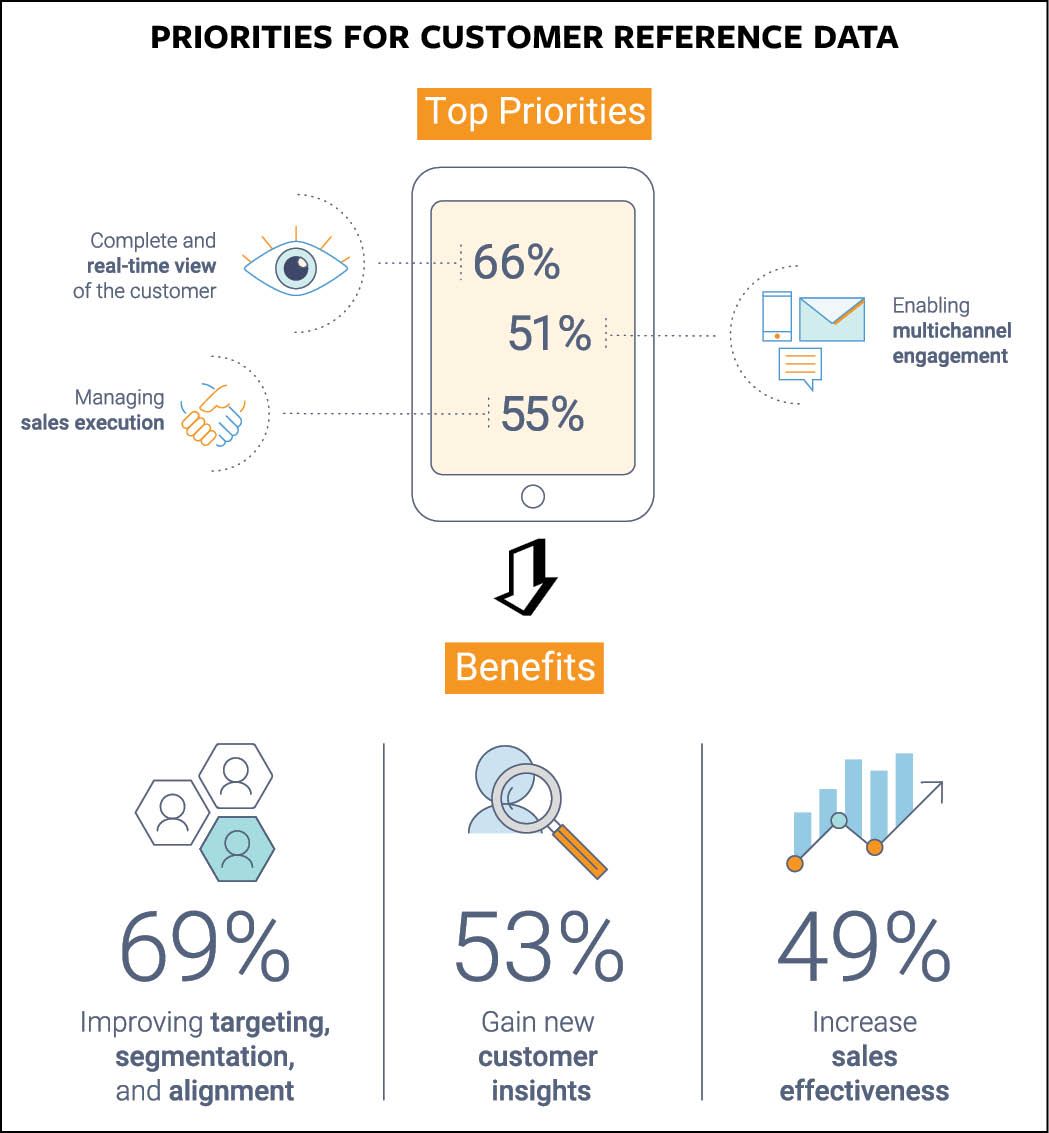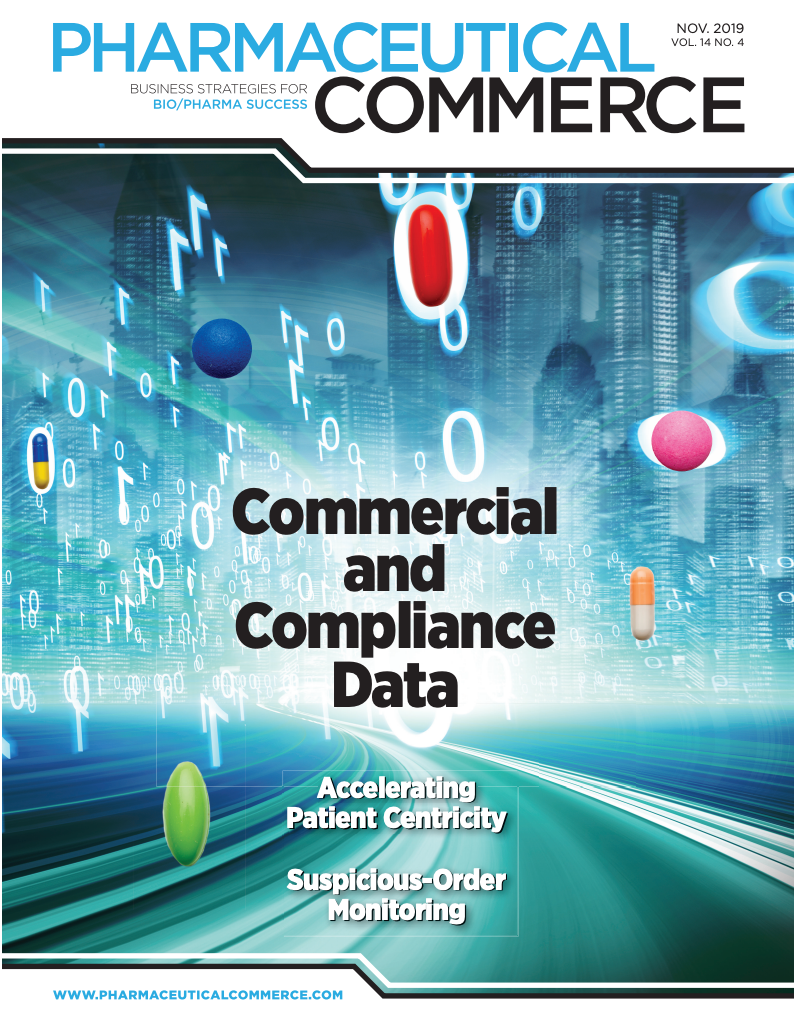The path to digital transformation runs through data
Key priorities: cleansed data and consolidated databases

Back in 2016, the life sciences industry was lagging 33 other sectors in digital transformation. [1] Today, that’s no longer true. But now, life sciences is not nearly as far behind as it used to be, says industry analyst Eric Newmark, program VP at IDC. In fact, the industry is implementing digital the right way and laying the groundwork for long-term, sustained success.
“Digital transformation is really about two things,” says Newmark. “Internally, it’s about putting data at the core of your business to drive better decisions quicker, faster, and easier; externally, it’s about putting the customer at the center by doing everything you can to add value and improve interactions. In all cases, data is the foundation of that digital transformation and pharma companies get it.”
Poor data quality is one of the main hindrances to digital transformation. Sales teams often have incorrect address and affiliation data or outdated information about a physician’s specialty and license status. Most operations, sales, marketing, regulatory, and IT professionals are not satisfied with the quality of their primary customer reference data. Even fewer are happy with their affiliations and hierarchy data to support daily sales operations. [2]
The industry is now taking action. Nearly 70% of life sciences companies surveyed by IDC in 2018 earmarked 25% to 50% of their digital transformation budget this year for improving data management and operationalizing data. [3] In fact, many already have data quality initiatives underway. [4] Advanced data management technology is helping companies leverage an increasing volume of data more efficiently.
As Newmark suggests, digital transformation hinges on companies making a data transformation – and most companies recognize the urgency of this fundamental first step. A strong data foundation enables companies to take full advantage of digital channels and the intelligence from advanced analytics technologies like artificial intelligence (AI) and machine learning.
Here’s how data transformation can clear the path for digital transformation.
Bring together diverse data sources
Every customer interaction, every call on a physician, everything we touch turns into data today. Many companies struggle to manage the overwhelming volume of data and many different data types and sources. Global enterprises, for example, can easily work with hundreds to thousands of data sources – and this data is often in both structured and unstructured formats, adding to the complexity and preventing the use of AI in any meaningful way.
Novartis CEO Vas Narasimhan, who announced his drive toward digital when he took the helm last year, said, “The first thing we’ve learned is the importance of having outstanding data to base your machine learning on. It’s taken us years just to clean datasets for a few big projects. I think people underestimate how little clean data there is out there, and how hard it is to clean.” [5]
Boehringer-Ingelheim’s Philippe Houben also talked about this issue during a roundtable discussion at the 2019 Veeva Commercial Summit. “We struggle with multiple different data sets that we are generating from all of the different digital channels. In addition, we have external data such as patient information from various sources including social media and wearables. It’s a difficult challenge.”
In order to leverage all of the best data sources available to life sciences companies, organizations need open data solutions that incorporate application program interfaces (APIs) for easy access to all data. Open data solutions provide field teams with a real-time, consolidated view of customers.
Solutions that also combine information from public sources, such as the American Medical Assn’s Physician Masterfile, American Hospital Assn, NPI database, and US state license boards create comprehensive and accurate customer profiles. Companies benefit with more precise targeting, increased commercial productivity, and deeper market penetration.
Click to view larger image

Fig. 1. A 2018 ‘State of Customer Reference Data’ survey by Veeva showed that a complete, real-time view of the customer is the top priority for pharma.[/caption]
Consolidate data on one platform
A unified data model can help companies consolidate their many data sources, versions, and systems; otherwise accuracy can be compromised. Specialty pharmaceutical company Indivior, for example, had two data systems and worked from 17 different versions of the same data source across North America and Europe. This left teams uncertain if they were working from the most current data. Indivior switched to a single data model with Veeva OpenData to help field teams effectively and compliantly deliver new treatment information to HCPs.
“We now have a single source of customer data that’s always accurate, which is key to digital engagement strategies and compliance,” said a spokesperson at Indivior.
A single global data platform also makes it easier to comply with changing privacy regulations. With consistent data management processes, life sciences companies can prevent risk and improve compliance.
Establish a single unique identifier
Life sciences companies have adopted various data management systems incrementally across geographies over the years, resulting in fragmented databases. The same HCP customer would be referenced differently in each disparate system so there is no single, reliable record. For example, how do companies accurately link interaction data from across all channels, payers, and specialty pharmacy sources to the right doctor if that doctor is in different databases with six different identifiers, six different times?
Customer data also sits in silos at the local level – creating data blind spots and impeding companies from implementing holistic digital transformation initiatives and harmonizing processes on a global scale. Without accurate and complete market coverage for each customer, companies will struggle to capture insights needed to personalize customer engagement and improve decision-making. And organizations cannot leverage all of their data assets across the globe to create a single, complete, and accurate view of each individual customer.
The solution is to assign each customer a single unique identifier (ID) that is recognized across systems, countries, data sources, and types globally. Field teams can then leverage different digital channels for each customer segment more effectively – an important advantage. Life sciences companies say that customer targeting, segmentation, and alignment is one of the top drivers for data improvement initiatives, in addition to the need for better customer insight. [4]
After establishing a unique ID for each customer, confirming each global customer record provides a clear picture of geographic location as well as affiliations for engaging with specialists and account selling. This information must be complete, accurate, and kept up to date in real time to avoid making business decisions on stale data. This is also why it’s so important to have a fast data change-request process with regionally based data stewards who can resolve requests in hours rather than weeks.
Build the right organizational structure
The right executive oversight is another key to operationalizing all of the data at the industry’s disposal. However, many pharmaceutical companies do not yet have the right organizational structure to oversee data efforts. [6]
The chief information officer of a large pharmaceutical company explained, “To manage its 5,000 data sources is a monumental achievement, made even more difficult without the right leadership in place,” he said. The companies with executive or senior management-level roles overseeing data transformation efforts are experiencing the most success. [6]
Fortunately, 90% of large companies are predicted to hire a chief data officer for the first time by the end of this year and many of them will be pharmaceutical or healthcare companies. [7] These hires are inspired by the industry’s move to digital transformation and should be carefully evaluated before embarking on a data transformation.
The key to intelligent engagement
The right data enables companies to take advantage of powerful analytics technologies, reach new markets, increase sales productivity with better targeting and segmentation, and improve decision-making thanks to rich customer insights that get better over time. Ultimately, high-quality data enables more intelligent interactions through more digital channels for successful customer engagement.
“Most senior leaders are so focused on strategy that they forget about the foundational data requirements essential to executing on that strategy,” says Joel VanderMeulen, senior director of commercial strategy operations and activities for EMD Serono’s Neurology and Immunology branches. “Veeva OpenData has helped us avoid product launch pitfalls and execute our digital strategy and tactics. Prior, a lot of strategic ideas didn’t take data into consideration – it was assumed that the data was available, complete, and of high quality, and we’d be able to implement any strategy or tactic. Turns out, that was not always the case. Now we have the foundation we need for digital.”
The sooner life sciences organizations recognize how fundamental data is digital transformation, the sooner they will see results and even drive past other industries on the road to digital transformation.
“Data is at the heart of what digital transformation’s all about. The industry needs reliable, high-quality data that’s accessible quickly,” concluded Newmark. “You can’t digitally transform, and make better decisions, if the data that’s driving those decisions isn’t accurate and available.”
About The Author
Logging over 20 years of healthcare and life sciences experience, Rebecca Silver is general manager for Veeva Global OpenData. Earlier, as VP, professional services, North America, she directed successful implementations of Veeva’s suite of commercial products at major pharmaceutical companies. In her career, Silver has managed product teams, operational teams, sales teams, and delivery teams to lead hundreds of successful customer engagements. Silver can be reached at [email protected]
References
1. Fox, Brian; Paley, Amit; Prevost, Michelle; and Subramian, Nisha. McKinsey, November 2016, “Closing the Digital Gap in Pharma.”
2. Veeva 2018 Customer Reference Data Survey
3. IDC, “IDC’s 2019 Industry Cloud Path Survey.
4. Veeva 2018 Customer Reference Data Survey
5. Forbes, January 16, 2019, “Novartis CEO Who Wanted to Bring Tech Into Pharma Now Explains Why it’s So Hard,” by David Shaywitz.
6. CIO Dive, October 2, 2019, “Pharma Sits on a Ton of Data. Its Infrastructure Doesn’t Quite Keep Up,” by Roberto Torres.
7. Health Tech Magazine, “Big Data in Healthcare: How Chief Data Officers Can Help,” by Brian Horowitz, June 2018.
